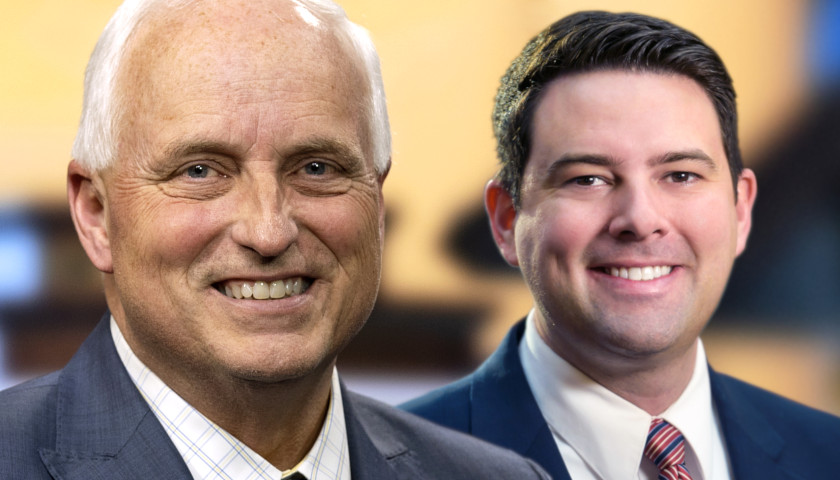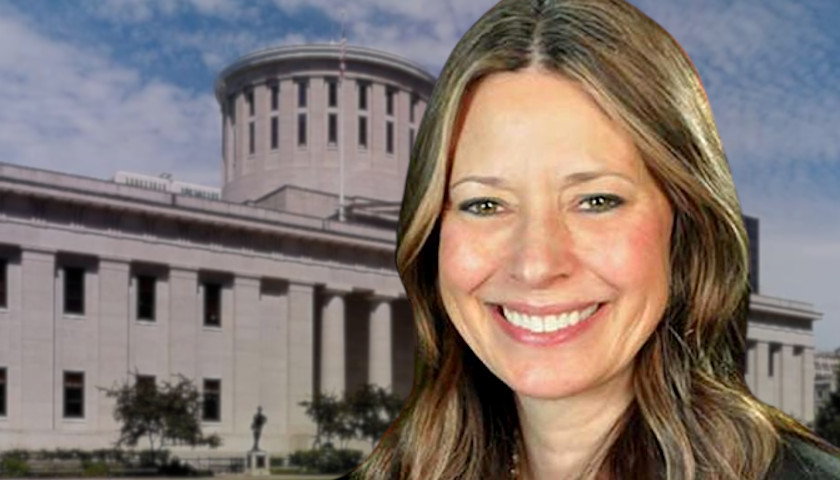COLUMBUS, Ohio – Last Wednesday Ohio Senate Bill 22 (SB22) passed the upper chamber 25-8 – all Republicans were in favor, all Democrats opposed.
SB22 was introduced by primary sponsors Terry Johnson (R-District 14)(pictured left) and Rob McColley (R-District 1)(pictured right), and establishes legislative oversight to the Governor’s and health orders.
In its original form, the bill granted the General Assembly authority to immediately rescind a public health state of emergency declaration along with rules and orders the Governor and Ohio Department of Health (ODH) issued related to a public a health state of emergency.
The first draft would have also put a 30-day limit on a public health state of emergency, while allowing the Ohio Health Oversight and Advisory Committee (OHOAC) – which is a bicameral, bipartisan commission established by the legislation – to rescind a state of emergency as well as orders and rules of the Governor and the Ohio Department of Health 10 days following issue.
However, while it was in the Senate Government Oversight and Reform Committee several amendments were made to the proposed statute.
The major changes include:
- state of emergency may be in effect for a maximum of 90 days – only the General Assembly can extend the effective date by concurrent resolution in 60-day intervals;
- the General Assembly may rescind an emergency order declaration after 30 days by concurrent resolution;
- Governor or agencies may not extend an expired or rescinded order, or one that is substantially similar, for 90 days unless the General Assembly extends by concurrent resolution;
- an executive order of the Governor or any special or standing rule of any agency in effect on the bill’s effective date is subject to review and rescission by both the OHOAC and General Assembly;
- state of emergency declaration in effect on the date of the order is considered to have the same effective date as the bill and may not be in effect for more than 90 days following the effective date unless the General Assembly extends the emergency;
- OHOAC slimmed from 10 members to six;
- OHOAC may not rescind a state of emergency declaration from the Governor but does have power to change, by majority vote, orders and rules of the Governor and agencies resulting from a state of emergency declaration.
A concurrent resolution is not a law and thus is not subject to a veto by the governor – it requires a simple majority vote in both the House and the Senate.
The Ohio House received the bill from the Senate last Thursday, where it has been assigned to the State and Local Government Committee, which is chaired by State Senator Scott Wiggam (R-Wooster). Wiggam told The Ohio Star in a phone interview that he expects the body to wrap up testimonies on a similar piece of legislation (House Bill 90) this week and to begin work on SB22 next.
That work will involve proponent and opponent testimony as well as changes to the bill before it is calendared for debate on the House floor, followed by a vote.
SB22 received enormous feedback from interested parties in the Senate.
Nearly 300 Ohioans from all corners of the state testified in favor, while less than 50 opposed – opponent testimony came, largely, from county health departments and government workers.
One of those testimonials came from Father Gabriel Lavery, a Catholic Priest. In his testimony Lavery described how he was not allowed bedside to pray with patients because of COVID. And on the matter of whether the Governor and ODH should be unchecked for 11 months he said:
Emergency powers are intended for one thing only: to take quick action when there is no time for the normal legislative process. The whole purpose is the presumption that the legislature does not have time meet and pass the necessary laws to react to an emergency. There is no reason to justify emergency powers continuing for 11 months. That is the bottom line.
The legislature has met multiple times and has had ample opportunity to act. Even if one agrees with every decision the governor and ODH made there is still no excuse for excluding the legislature from those decisions for this long. Nor can it be good to have life-altering decisions made by so few.
If a doctor told you he needed to amputate a leg would you not want a second opinion? What if the doctor insisted for 11 months that you were not allowed to get a second opinion because it is an emergency? What if you were fined and threatened by the doctor for not complying? This is completely unreasonable and needs to stop.
However, the Ohio Legislative Service Commission (OLSC) – a nonpartisan agency providing the Ohio General Assembly with drafting, research, budget and fiscal analysis – submitted their customary bill analysis, which indicated the legislation may contain a constitutional snag.
In their commentary, OLSC stated the legislative branch passes laws while the executive branch enforces laws, and it is unclear if the Ohio Legislature can both provide executive branch authority to issue orders and determine which resulting orders are valid.
The specific issue is whether the General Assembly and OHOAC may tinker with orders and rules issued by the Governor and State of Ohio agencies without issuing a new law.
OLSC did admit that the Ohio courts have not directly addressed the issue, but the Supreme Court of the United States did rule that “once Congress makes its choice in enacting legislation, its participation ends.”
Additionally, The Ohio Supreme Court, according to OLSC, once held that a “joint resolution cannot have the effect of law.”
One Ohio State Senator told The Star that there are already committees that oversee state agencies and even adjustments to the state budget without introducing bills.
The Joint Commission on Agency Rule Review (JCARR) and the State of Ohio Controlling Board are both examples of bicameral and bipartisan committees that change administrative codes and authorize spending, respectively.
The lawmaker surmised that the constitutionality of the matter was raised by an insider that was opening a door for a legal challenge for opponents of the bill.
The Star contacted the Ohio Attorney General about the legality of the matter, but the AG’s office did dot respond by press time.
One attorney, who talked with The Star on the condition of anonymity, took the Senator’s idea a step further by saying that SB22’s use of a concurrent resolution to rescind orders and rules “is so flawed that [it was perhaps] intentionally inserted by dishonest legislators to posture to the public that they are accomplishing something all while actually accomplishing nothing.”
Another attorney, Maurice Thompson of the 1851 Center for Constitutional Law, also talked with The Star and said that SB22 is similar to HB90 – the latter was also flagged by OLSC for the same potential constitutional issue.
In his public testimony on HB90, Thompson called the OLSC analysis “weak.”
Thompson said “agencies derive their order and rulemaking authority from the General Assembly. The General Assembly is relatively free to impose conditions on how the delegated authority may be exercised.
In fact, imposing some conditions is an improvement over status quo, whereby health departments are impermissibly untethered from any conditions or standards binding their conduct.”
Yet Thompson did provide four key changes to HB90 to make it more legally palatable:
- remove text stating “under ORC 3701.13” [the code under which original orders were based but subsequent orders referenced different sections of the state code];
- cause orders and rules to expire if not approved by the General Assembly, JCARR or another committee, rather than attempting to repeal administrative orders through General Assembly resolution or committee action;
- prohibit the extension of “any restriction in any prior order,” rather than or in addition to prohibiting extension through any “substantially similar order;”
- Add “teeth” to better permit affected citizens to enforce the limits the General Assembly is implementing by authorizing Ohioans to initiate litigation to challenge rules and orders that violate those terms in their home counties rather than Franklin County Court of Common Pleas [a move Governor DeWine made in many cases filed against the State to get the matters in front of more liberal judges].
Wiggam, a primary sponsor of HB90, said the House will produce a sub bill containing Thompson’s recommendations before sending it to the Senate.
When asked about the differences between HB90 and SB22 – which appear almost identical in their original forms – Wiggam said the Senate had a head start on the House, which didn’t select committees and committee leadership until February and was able to get their bill out first.
The Wooster Rep also noted that the House will go one direction on HB90 – keeping the General Assembly’s power to immediately rescind a state of emergency and limiting one to 30 days – while the Senate has softened SB22 by removing provisions which would have immediately struck down an emergency order, while extending its effective date from 30 to 90 days.
Nonetheless, SB22 passed the Senate with full Republican support. And the final floor speech before the bill was voted on was given by Senator Johnson – a doctor and combat medic.
In his statements Johnson confronted the idea from Senate Democrats who gave speeches opposed to SB22 that questioning the Governor and ODH orders was akin to playing “armchair quarterback.”
Johnson reminded the assembly that they are Senators, not armchair quarterbacks– the voice of Ohioans, closer to the desire of the people than a few folks in the executive branch.
He also said that he noticed how many private citizens came to testify in favor of the bill, as opposed the few detractors he believed were influenced by “lobbyists.”
Johnson also said that COVID spread and the virus’s toll in areas where strict mandates and measures were enforced are sometimes worse than areas with loose-to-no restrictions, and that public health measures are not conclusive.
In fact, Johnson said, stopping a novel virus is like standing at the beach trying to stop the tide or attempting to direct the wind – it’s “a farce.”
SB22 does not contain an emergency provision, which means the measure would go into effect 90 days following override votes, first in the Senate, then in the House. DeWine already said he would veto the bill.
Based on the amount of time the bill was in the Senate and the 10-day waiting period the Governor would exhaust before vetoing, the statue would likely be effective sometime in July.
In order to override a veto, SB22 would need at least 20 votes the second go round in the upper chamber and 60 in the House. If an emergency provision – which would make the law effective immediately – were attached, the Senate would need 22 “yes” votes and the House 66.
– – –
Jack Windsor is State House Reporter at The Ohio Star and the Star News Network. Windsor is also an independent investigative reporter. Follow Jack on Twitter. Email tips to [email protected].





